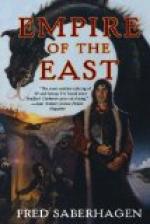His ambition is to see the road connecting his district with Podgorica finished, which would bring the two towns within a six hours’ drive of each other, instead of the present two days’ very hard riding. The benefit to Kolasin is obvious. At present the vast beech forests, literally rotting, could be utilised, for wood is dear in the barren districts of Montenegro. Pyrite, too, is found in great quantities. In fact, Kolasin is cut off from the rest of the country. Everything must be painfully carried on horses or mules, and for a woman, other than a peasant, it is a journey of great difficulty. Side saddles are things unknown, and we heard of one lady, the wife of a foreign minister, who bravely undertook the journey, spending six days on the way from Podgorica. The Governor gave us a graphic description of the difficulties that he had experienced when he brought his family up here.
We also visited the local doctor, a most extraordinary individual with a crank. He had started a Montenegrin temperance society, called the “Band of Good Hope.” At present, I believe, the three hundred odd members were all from Kolasin, and it was meeting with very little encouragement. The cultivation of plums for the manufacture of spirits is a staple industry, and these peasants wish to know what they shall do with their fruit. Besides, as the Montenegrins very rarely get drunk, it seems rather an unnecessary movement, and the Prince himself does not favour it.
Bismarck once said that England’s greatness began to diminish when the “three-bottle man” died out; perhaps Prince Nicolas has like thoughts of his hardy subjects, who certainly can consume enormous quantities of alcohol with impunity. Besides, it would destroy a large source of the revenue, which Montenegro cannot afford to do. In the meantime the gallant three hundred feel very unhappy.
The few days that we spent in Kolasin were passed pleasantly in daily excursions into the surrounding country shooting, though with indifferent results. The Crown Prince Danilo’s birthday came one day during our stay, and Governor, staff, and officials went to church attired in glorious raiment. They literally sparkle in gold lace embroidery, orders, and decorations, and for a gorgeous but absolutely tasteful effect commend me to the gala dress of the Montenegrin high official. It is the most artistic blending of gold, crimson, blue, and white.
After the service spirits were served out free on the market-place (what agonies must the three hundred have suffered!), and a dance was formed. The national dance—in this instance the “kolo”—is usually performed by men, though the women do sometimes join in, and it is a slow and stately measure.
[Illustration: THE KOLASIN MARKET PLACE]
[Illustration: THE KOLO]
The men place their hands on each other’s shoulders and form a ring, which, however, is never completed. New men can join in, but a space is always left open. One step is taken sideways to the left, and then three to the right, and the movement is accompanied by singing. The singers are three or four men on the opposite horns of the circle, who alternately chant verses in honour of the Prince.




